Organisational Behaviour Report: Sainsbury's Analysis and Evaluation
VerifiedAdded on 2021/02/21
|20
|6158
|22
Report
AI Summary
This report delves into the realm of organisational behaviour, using Sainsbury's as a case study to illustrate key concepts. It begins with an analysis of the company's culture, power dynamics, and the impact of organizational politics on individual and team performance. The report then evaluates content and process theories of motivation, exploring various motivational techniques. Furthermore, it differentiates between effective and ineffective teams, highlighting the factors that contribute to team success. Finally, the report examines the concepts and philosophies of organisational behaviour within an organizational context, providing a comprehensive overview of the subject matter. The report's structure includes an introduction, four tasks, a conclusion, and references, demonstrating a clear and organized approach to the analysis.
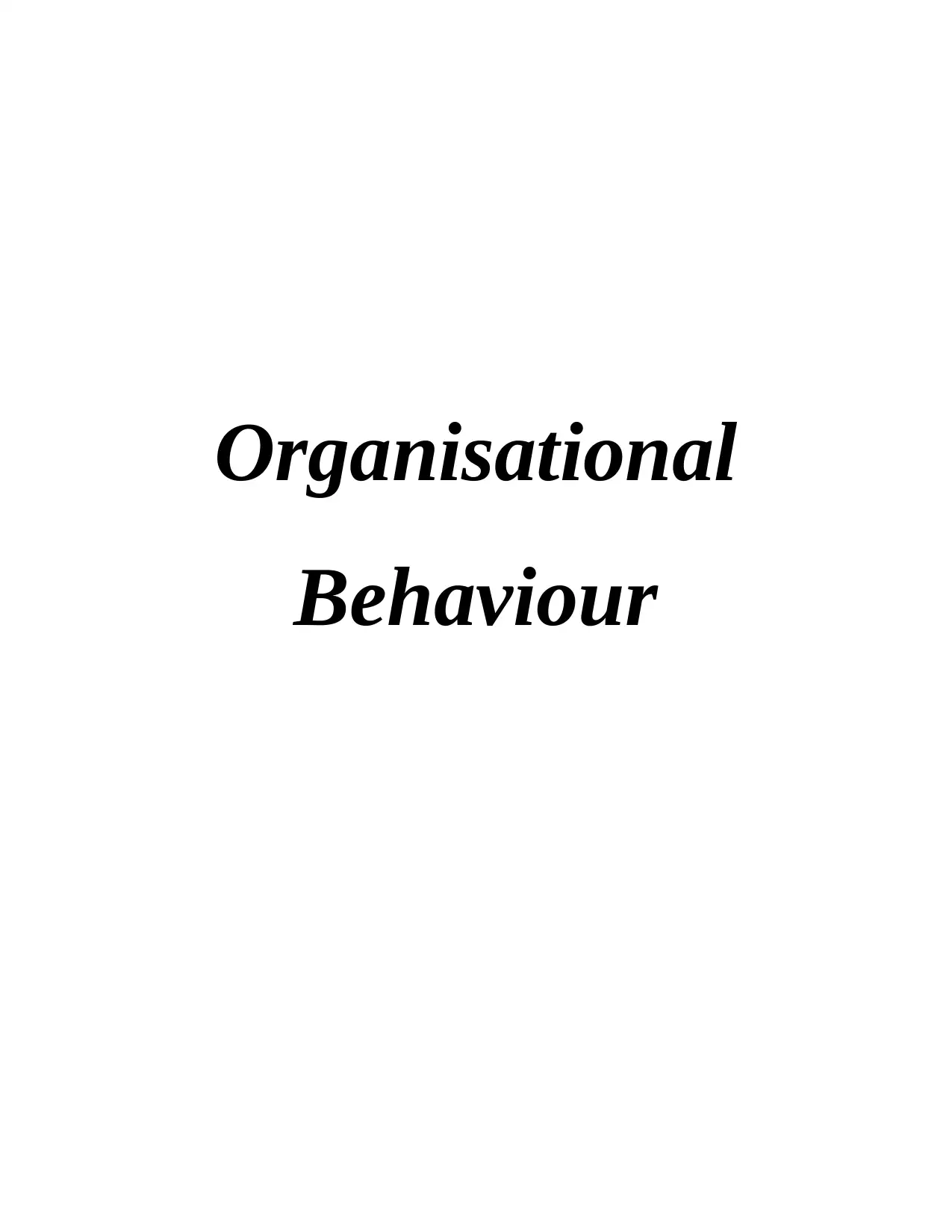
Organisational
Behaviour
Behaviour
Paraphrase This Document
Need a fresh take? Get an instant paraphrase of this document with our AI Paraphraser
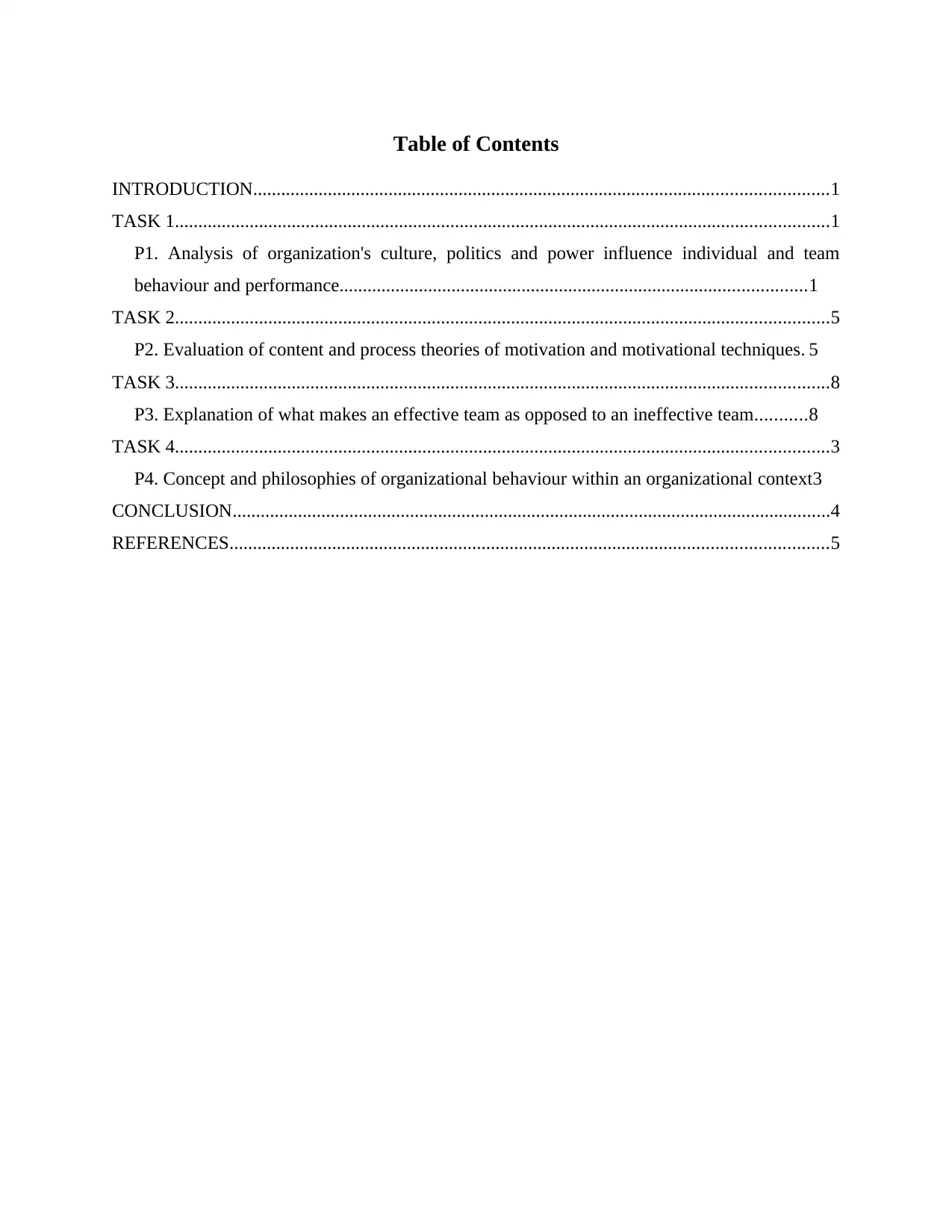
Table of Contents
INTRODUCTION...........................................................................................................................1
TASK 1............................................................................................................................................1
P1. Analysis of organization's culture, politics and power influence individual and team
behaviour and performance....................................................................................................1
TASK 2............................................................................................................................................5
P2. Evaluation of content and process theories of motivation and motivational techniques. 5
TASK 3............................................................................................................................................8
P3. Explanation of what makes an effective team as opposed to an ineffective team...........8
TASK 4............................................................................................................................................3
P4. Concept and philosophies of organizational behaviour within an organizational context3
CONCLUSION................................................................................................................................4
REFERENCES................................................................................................................................5
INTRODUCTION...........................................................................................................................1
TASK 1............................................................................................................................................1
P1. Analysis of organization's culture, politics and power influence individual and team
behaviour and performance....................................................................................................1
TASK 2............................................................................................................................................5
P2. Evaluation of content and process theories of motivation and motivational techniques. 5
TASK 3............................................................................................................................................8
P3. Explanation of what makes an effective team as opposed to an ineffective team...........8
TASK 4............................................................................................................................................3
P4. Concept and philosophies of organizational behaviour within an organizational context3
CONCLUSION................................................................................................................................4
REFERENCES................................................................................................................................5
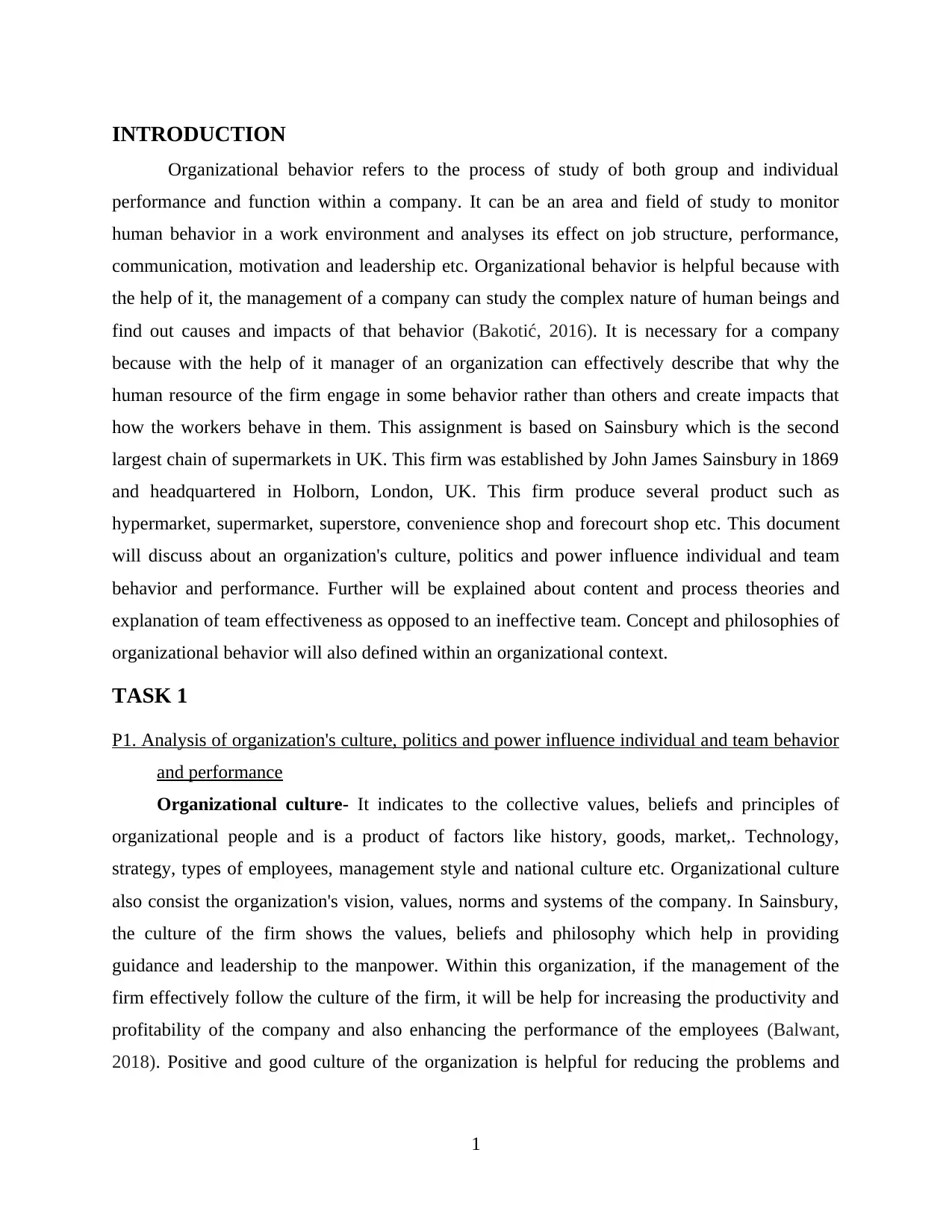
INTRODUCTION
Organizational behavior refers to the process of study of both group and individual
performance and function within a company. It can be an area and field of study to monitor
human behavior in a work environment and analyses its effect on job structure, performance,
communication, motivation and leadership etc. Organizational behavior is helpful because with
the help of it, the management of a company can study the complex nature of human beings and
find out causes and impacts of that behavior (Bakotić, 2016). It is necessary for a company
because with the help of it manager of an organization can effectively describe that why the
human resource of the firm engage in some behavior rather than others and create impacts that
how the workers behave in them. This assignment is based on Sainsbury which is the second
largest chain of supermarkets in UK. This firm was established by John James Sainsbury in 1869
and headquartered in Holborn, London, UK. This firm produce several product such as
hypermarket, supermarket, superstore, convenience shop and forecourt shop etc. This document
will discuss about an organization's culture, politics and power influence individual and team
behavior and performance. Further will be explained about content and process theories and
explanation of team effectiveness as opposed to an ineffective team. Concept and philosophies of
organizational behavior will also defined within an organizational context.
TASK 1
P1. Analysis of organization's culture, politics and power influence individual and team behavior
and performance
Organizational culture- It indicates to the collective values, beliefs and principles of
organizational people and is a product of factors like history, goods, market,. Technology,
strategy, types of employees, management style and national culture etc. Organizational culture
also consist the organization's vision, values, norms and systems of the company. In Sainsbury,
the culture of the firm shows the values, beliefs and philosophy which help in providing
guidance and leadership to the manpower. Within this organization, if the management of the
firm effectively follow the culture of the firm, it will be help for increasing the productivity and
profitability of the company and also enhancing the performance of the employees (Balwant,
2018). Positive and good culture of the organization is helpful for reducing the problems and
1
Organizational behavior refers to the process of study of both group and individual
performance and function within a company. It can be an area and field of study to monitor
human behavior in a work environment and analyses its effect on job structure, performance,
communication, motivation and leadership etc. Organizational behavior is helpful because with
the help of it, the management of a company can study the complex nature of human beings and
find out causes and impacts of that behavior (Bakotić, 2016). It is necessary for a company
because with the help of it manager of an organization can effectively describe that why the
human resource of the firm engage in some behavior rather than others and create impacts that
how the workers behave in them. This assignment is based on Sainsbury which is the second
largest chain of supermarkets in UK. This firm was established by John James Sainsbury in 1869
and headquartered in Holborn, London, UK. This firm produce several product such as
hypermarket, supermarket, superstore, convenience shop and forecourt shop etc. This document
will discuss about an organization's culture, politics and power influence individual and team
behavior and performance. Further will be explained about content and process theories and
explanation of team effectiveness as opposed to an ineffective team. Concept and philosophies of
organizational behavior will also defined within an organizational context.
TASK 1
P1. Analysis of organization's culture, politics and power influence individual and team behavior
and performance
Organizational culture- It indicates to the collective values, beliefs and principles of
organizational people and is a product of factors like history, goods, market,. Technology,
strategy, types of employees, management style and national culture etc. Organizational culture
also consist the organization's vision, values, norms and systems of the company. In Sainsbury,
the culture of the firm shows the values, beliefs and philosophy which help in providing
guidance and leadership to the manpower. Within this organization, if the management of the
firm effectively follow the culture of the firm, it will be help for increasing the productivity and
profitability of the company and also enhancing the performance of the employees (Balwant,
2018). Positive and good culture of the organization is helpful for reducing the problems and
1
⊘ This is a preview!⊘
Do you want full access?
Subscribe today to unlock all pages.

Trusted by 1+ million students worldwide

issues which are generating in the firm. The management of Sainsbury can use different model of
culture to monitor the effective of it, some of them are defined as following:
Handy's Model of organisational culture
This model is formulated by Charles Handy to monitor the culture of an organisation.
This model consist various elements and they are mentioned as below:
Power culture- Within this factor, the power of decision making is having by some
people and they are only responsible to take decision in context of any problem and issue
(Bester, Stander and Van Zyl, 2015). In Sainsbury, manager are some specific individual who are
responsible to take decision and they have not any need and requirement of consulting with the
employees. This type of culture is not good for the firm because it does not useful and beneficial
for the growth and development of the company because it generate demotivation within the
employees and they feel that they are not important resources for the organisation. It create
unfavourable impact upon team and individual because due to lack of motivation they do not
their efforts and effectiveness for the growth of the company an it affect team work and task.
Role culture- It is another element and under it, the manger of the company is
responsible for sharing all the information and data which is required and needed to other people.
This type of culture is highly job oriented and can often be found in bureaucratic firms. This type
culture is not flexible in nature. In Sainsbury, the roles and responsibilities is assigned by the
management of the company to the employees according to their skills and competencies. It
positively affect the company because if the manager of respective company play their role
properly then it encourage employees and team and attain their objectives appropriately.
Task culture- This is the another component of this model and according to it, the work
and task are allotted to the workers of the company by determining their knowledge and skills. In
Sainsbury, the administration of the firm assigned the work to the employees according their
capabilities and competencies. So that it can be monitored that they are able to perform any task
or not. In some cases, the manager of the company provide work to the workers to monitor the
past performance of them. It favourably affect the team and individual behaviour because if the
work is allotted to them as per their knowledge and skills and then complete it in effective
manner and adequately accomplish task objectives.
Person culture- This culture can be often found in professional organisations where
people are totally independent and have effective education and work by using their own
2
culture to monitor the effective of it, some of them are defined as following:
Handy's Model of organisational culture
This model is formulated by Charles Handy to monitor the culture of an organisation.
This model consist various elements and they are mentioned as below:
Power culture- Within this factor, the power of decision making is having by some
people and they are only responsible to take decision in context of any problem and issue
(Bester, Stander and Van Zyl, 2015). In Sainsbury, manager are some specific individual who are
responsible to take decision and they have not any need and requirement of consulting with the
employees. This type of culture is not good for the firm because it does not useful and beneficial
for the growth and development of the company because it generate demotivation within the
employees and they feel that they are not important resources for the organisation. It create
unfavourable impact upon team and individual because due to lack of motivation they do not
their efforts and effectiveness for the growth of the company an it affect team work and task.
Role culture- It is another element and under it, the manger of the company is
responsible for sharing all the information and data which is required and needed to other people.
This type of culture is highly job oriented and can often be found in bureaucratic firms. This type
culture is not flexible in nature. In Sainsbury, the roles and responsibilities is assigned by the
management of the company to the employees according to their skills and competencies. It
positively affect the company because if the manager of respective company play their role
properly then it encourage employees and team and attain their objectives appropriately.
Task culture- This is the another component of this model and according to it, the work
and task are allotted to the workers of the company by determining their knowledge and skills. In
Sainsbury, the administration of the firm assigned the work to the employees according their
capabilities and competencies. So that it can be monitored that they are able to perform any task
or not. In some cases, the manager of the company provide work to the workers to monitor the
past performance of them. It favourably affect the team and individual behaviour because if the
work is allotted to them as per their knowledge and skills and then complete it in effective
manner and adequately accomplish task objectives.
Person culture- This culture can be often found in professional organisations where
people are totally independent and have effective education and work by using their own
2
Paraphrase This Document
Need a fresh take? Get an instant paraphrase of this document with our AI Paraphraser

expertise. In Sainsbury, this type of culture make focus on growth of the competencies and
knowledge of the employees so that they can do their work and duties in appropriate manner. In
this organisation, for this the management of the firm organise training and learning sessions and
programs so that with the help of it the workers can make improvement in their skills and
knowledge (Burrell and Morgan, 2017). It is also beneficial for the employees for their
development and as well as firm to make enhancement in the growth and development of it
because it favourably affect the team and individual behaviour.. Because the by proving training
they can improve skills of employees which help in meeting objective of task effectively.
As per the defined information, it can be analysed that role culture is effective and
suitable for Sainsbury because within this culture, duties and responsibilities are allotted to the
workers according their skills and competencies which is appropriate for the growth of the firm
(Chang and et. al., 2016).
Hofstead cultural dimension model
This model consist various component, some of them are defined as following:
Masculinity vs Femininity- It is first element of this model and it is affiliated with the
effect of any kind of variation of the beliefs on the organisational culture. In Sainsbury, the factor
can be monitored by analysing the number of male and female workers. In several organisations,
mostly female employees do not perform their duties and responsibilities in appropriate manners
which affect the result unfavourably. For example, in US people prefer masculinity in their
organisational culture whereas in UK, the culture of organisation prefer femininity.
Individualism and collectivism- It is another component of this model and it is affiliated
with favourable components which are utilized by the workers of a firm to do their work or
competing their duties in a team and doing help in the growth of the firm. In Sainsbury, it mainly
applied by the human resource of the firm at the time of decision making. Because this element
majorly concentrate to design strategies and plans for completing the allotted work in appropriate
manner. For example, in US employees are more focus on collective of team work whereas in
UK people are concentrate on work independently.
Index of uncertainty avoidance- This dimension of culture considers the extent to which
uncertainty and avoidance are endure. In Sainsbury, according to this component, employees will
requirement to face complex and unexpected situation with in the working environment of the
firm. It is effective for the company because with the help of it the management can make
3
knowledge of the employees so that they can do their work and duties in appropriate manner. In
this organisation, for this the management of the firm organise training and learning sessions and
programs so that with the help of it the workers can make improvement in their skills and
knowledge (Burrell and Morgan, 2017). It is also beneficial for the employees for their
development and as well as firm to make enhancement in the growth and development of it
because it favourably affect the team and individual behaviour.. Because the by proving training
they can improve skills of employees which help in meeting objective of task effectively.
As per the defined information, it can be analysed that role culture is effective and
suitable for Sainsbury because within this culture, duties and responsibilities are allotted to the
workers according their skills and competencies which is appropriate for the growth of the firm
(Chang and et. al., 2016).
Hofstead cultural dimension model
This model consist various component, some of them are defined as following:
Masculinity vs Femininity- It is first element of this model and it is affiliated with the
effect of any kind of variation of the beliefs on the organisational culture. In Sainsbury, the factor
can be monitored by analysing the number of male and female workers. In several organisations,
mostly female employees do not perform their duties and responsibilities in appropriate manners
which affect the result unfavourably. For example, in US people prefer masculinity in their
organisational culture whereas in UK, the culture of organisation prefer femininity.
Individualism and collectivism- It is another component of this model and it is affiliated
with favourable components which are utilized by the workers of a firm to do their work or
competing their duties in a team and doing help in the growth of the firm. In Sainsbury, it mainly
applied by the human resource of the firm at the time of decision making. Because this element
majorly concentrate to design strategies and plans for completing the allotted work in appropriate
manner. For example, in US employees are more focus on collective of team work whereas in
UK people are concentrate on work independently.
Index of uncertainty avoidance- This dimension of culture considers the extent to which
uncertainty and avoidance are endure. In Sainsbury, according to this component, employees will
requirement to face complex and unexpected situation with in the working environment of the
firm. It is effective for the company because with the help of it the management can make
3
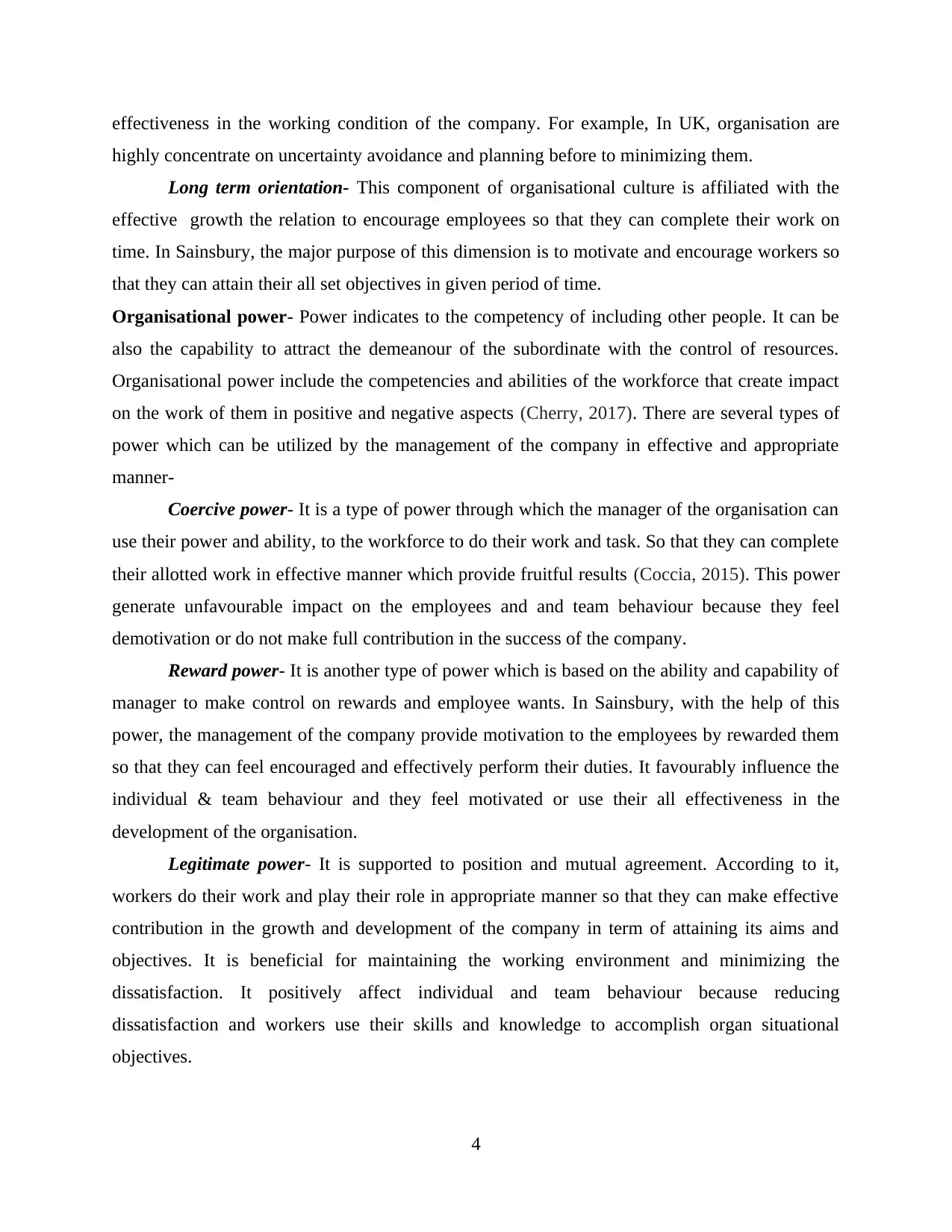
effectiveness in the working condition of the company. For example, In UK, organisation are
highly concentrate on uncertainty avoidance and planning before to minimizing them.
Long term orientation- This component of organisational culture is affiliated with the
effective growth the relation to encourage employees so that they can complete their work on
time. In Sainsbury, the major purpose of this dimension is to motivate and encourage workers so
that they can attain their all set objectives in given period of time.
Organisational power- Power indicates to the competency of including other people. It can be
also the capability to attract the demeanour of the subordinate with the control of resources.
Organisational power include the competencies and abilities of the workforce that create impact
on the work of them in positive and negative aspects (Cherry, 2017). There are several types of
power which can be utilized by the management of the company in effective and appropriate
manner-
Coercive power- It is a type of power through which the manager of the organisation can
use their power and ability, to the workforce to do their work and task. So that they can complete
their allotted work in effective manner which provide fruitful results (Coccia, 2015). This power
generate unfavourable impact on the employees and and team behaviour because they feel
demotivation or do not make full contribution in the success of the company.
Reward power- It is another type of power which is based on the ability and capability of
manager to make control on rewards and employee wants. In Sainsbury, with the help of this
power, the management of the company provide motivation to the employees by rewarded them
so that they can feel encouraged and effectively perform their duties. It favourably influence the
individual & team behaviour and they feel motivated or use their all effectiveness in the
development of the organisation.
Legitimate power- It is supported to position and mutual agreement. According to it,
workers do their work and play their role in appropriate manner so that they can make effective
contribution in the growth and development of the company in term of attaining its aims and
objectives. It is beneficial for maintaining the working environment and minimizing the
dissatisfaction. It positively affect individual and team behaviour because reducing
dissatisfaction and workers use their skills and knowledge to accomplish organ situational
objectives.
4
highly concentrate on uncertainty avoidance and planning before to minimizing them.
Long term orientation- This component of organisational culture is affiliated with the
effective growth the relation to encourage employees so that they can complete their work on
time. In Sainsbury, the major purpose of this dimension is to motivate and encourage workers so
that they can attain their all set objectives in given period of time.
Organisational power- Power indicates to the competency of including other people. It can be
also the capability to attract the demeanour of the subordinate with the control of resources.
Organisational power include the competencies and abilities of the workforce that create impact
on the work of them in positive and negative aspects (Cherry, 2017). There are several types of
power which can be utilized by the management of the company in effective and appropriate
manner-
Coercive power- It is a type of power through which the manager of the organisation can
use their power and ability, to the workforce to do their work and task. So that they can complete
their allotted work in effective manner which provide fruitful results (Coccia, 2015). This power
generate unfavourable impact on the employees and and team behaviour because they feel
demotivation or do not make full contribution in the success of the company.
Reward power- It is another type of power which is based on the ability and capability of
manager to make control on rewards and employee wants. In Sainsbury, with the help of this
power, the management of the company provide motivation to the employees by rewarded them
so that they can feel encouraged and effectively perform their duties. It favourably influence the
individual & team behaviour and they feel motivated or use their all effectiveness in the
development of the organisation.
Legitimate power- It is supported to position and mutual agreement. According to it,
workers do their work and play their role in appropriate manner so that they can make effective
contribution in the growth and development of the company in term of attaining its aims and
objectives. It is beneficial for maintaining the working environment and minimizing the
dissatisfaction. It positively affect individual and team behaviour because reducing
dissatisfaction and workers use their skills and knowledge to accomplish organ situational
objectives.
4
⊘ This is a preview!⊘
Do you want full access?
Subscribe today to unlock all pages.

Trusted by 1+ million students worldwide
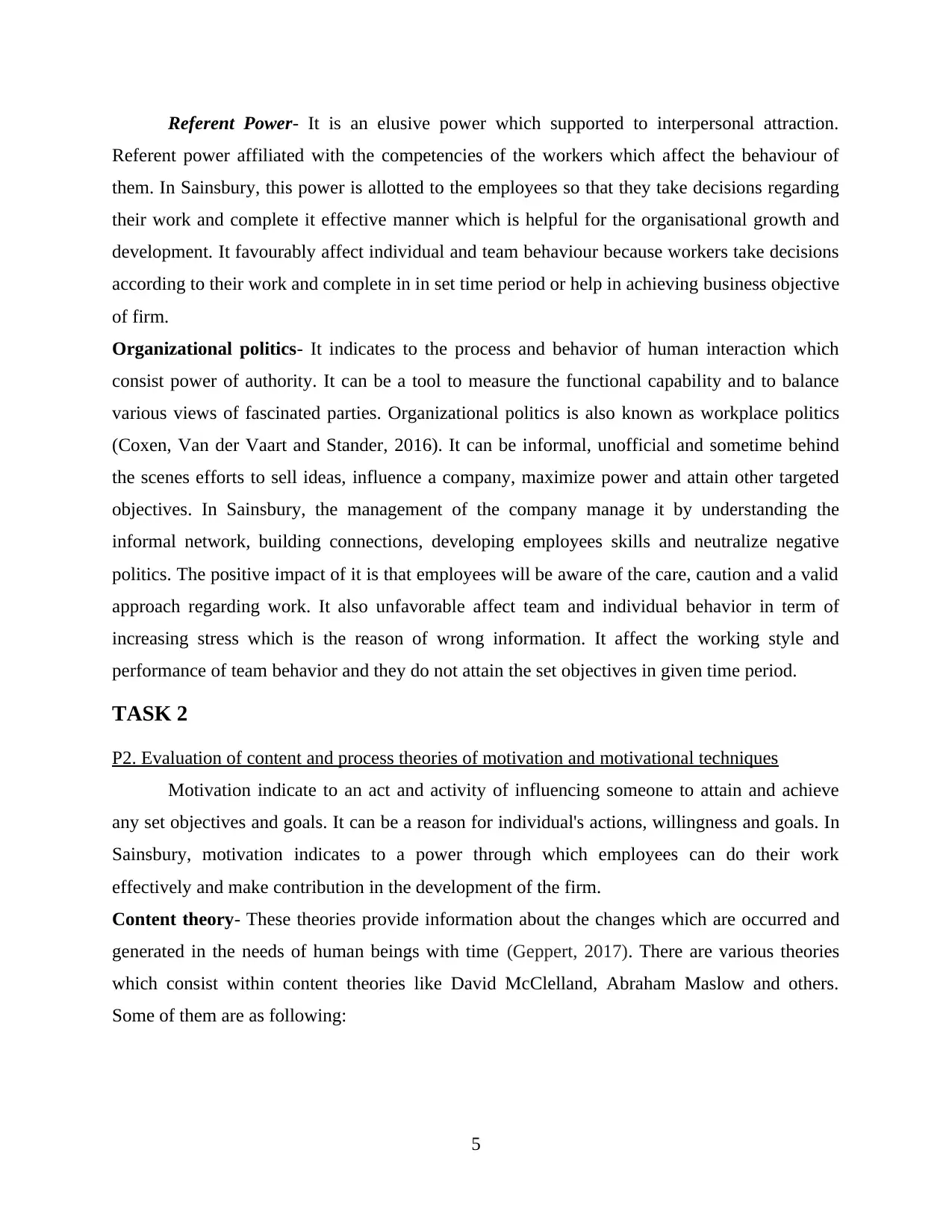
Referent Power- It is an elusive power which supported to interpersonal attraction.
Referent power affiliated with the competencies of the workers which affect the behaviour of
them. In Sainsbury, this power is allotted to the employees so that they take decisions regarding
their work and complete it effective manner which is helpful for the organisational growth and
development. It favourably affect individual and team behaviour because workers take decisions
according to their work and complete in in set time period or help in achieving business objective
of firm.
Organizational politics- It indicates to the process and behavior of human interaction which
consist power of authority. It can be a tool to measure the functional capability and to balance
various views of fascinated parties. Organizational politics is also known as workplace politics
(Coxen, Van der Vaart and Stander, 2016). It can be informal, unofficial and sometime behind
the scenes efforts to sell ideas, influence a company, maximize power and attain other targeted
objectives. In Sainsbury, the management of the company manage it by understanding the
informal network, building connections, developing employees skills and neutralize negative
politics. The positive impact of it is that employees will be aware of the care, caution and a valid
approach regarding work. It also unfavorable affect team and individual behavior in term of
increasing stress which is the reason of wrong information. It affect the working style and
performance of team behavior and they do not attain the set objectives in given time period.
TASK 2
P2. Evaluation of content and process theories of motivation and motivational techniques
Motivation indicate to an act and activity of influencing someone to attain and achieve
any set objectives and goals. It can be a reason for individual's actions, willingness and goals. In
Sainsbury, motivation indicates to a power through which employees can do their work
effectively and make contribution in the development of the firm.
Content theory- These theories provide information about the changes which are occurred and
generated in the needs of human beings with time (Geppert, 2017). There are various theories
which consist within content theories like David McClelland, Abraham Maslow and others.
Some of them are as following:
5
Referent power affiliated with the competencies of the workers which affect the behaviour of
them. In Sainsbury, this power is allotted to the employees so that they take decisions regarding
their work and complete it effective manner which is helpful for the organisational growth and
development. It favourably affect individual and team behaviour because workers take decisions
according to their work and complete in in set time period or help in achieving business objective
of firm.
Organizational politics- It indicates to the process and behavior of human interaction which
consist power of authority. It can be a tool to measure the functional capability and to balance
various views of fascinated parties. Organizational politics is also known as workplace politics
(Coxen, Van der Vaart and Stander, 2016). It can be informal, unofficial and sometime behind
the scenes efforts to sell ideas, influence a company, maximize power and attain other targeted
objectives. In Sainsbury, the management of the company manage it by understanding the
informal network, building connections, developing employees skills and neutralize negative
politics. The positive impact of it is that employees will be aware of the care, caution and a valid
approach regarding work. It also unfavorable affect team and individual behavior in term of
increasing stress which is the reason of wrong information. It affect the working style and
performance of team behavior and they do not attain the set objectives in given time period.
TASK 2
P2. Evaluation of content and process theories of motivation and motivational techniques
Motivation indicate to an act and activity of influencing someone to attain and achieve
any set objectives and goals. It can be a reason for individual's actions, willingness and goals. In
Sainsbury, motivation indicates to a power through which employees can do their work
effectively and make contribution in the development of the firm.
Content theory- These theories provide information about the changes which are occurred and
generated in the needs of human beings with time (Geppert, 2017). There are various theories
which consist within content theories like David McClelland, Abraham Maslow and others.
Some of them are as following:
5
Paraphrase This Document
Need a fresh take? Get an instant paraphrase of this document with our AI Paraphraser
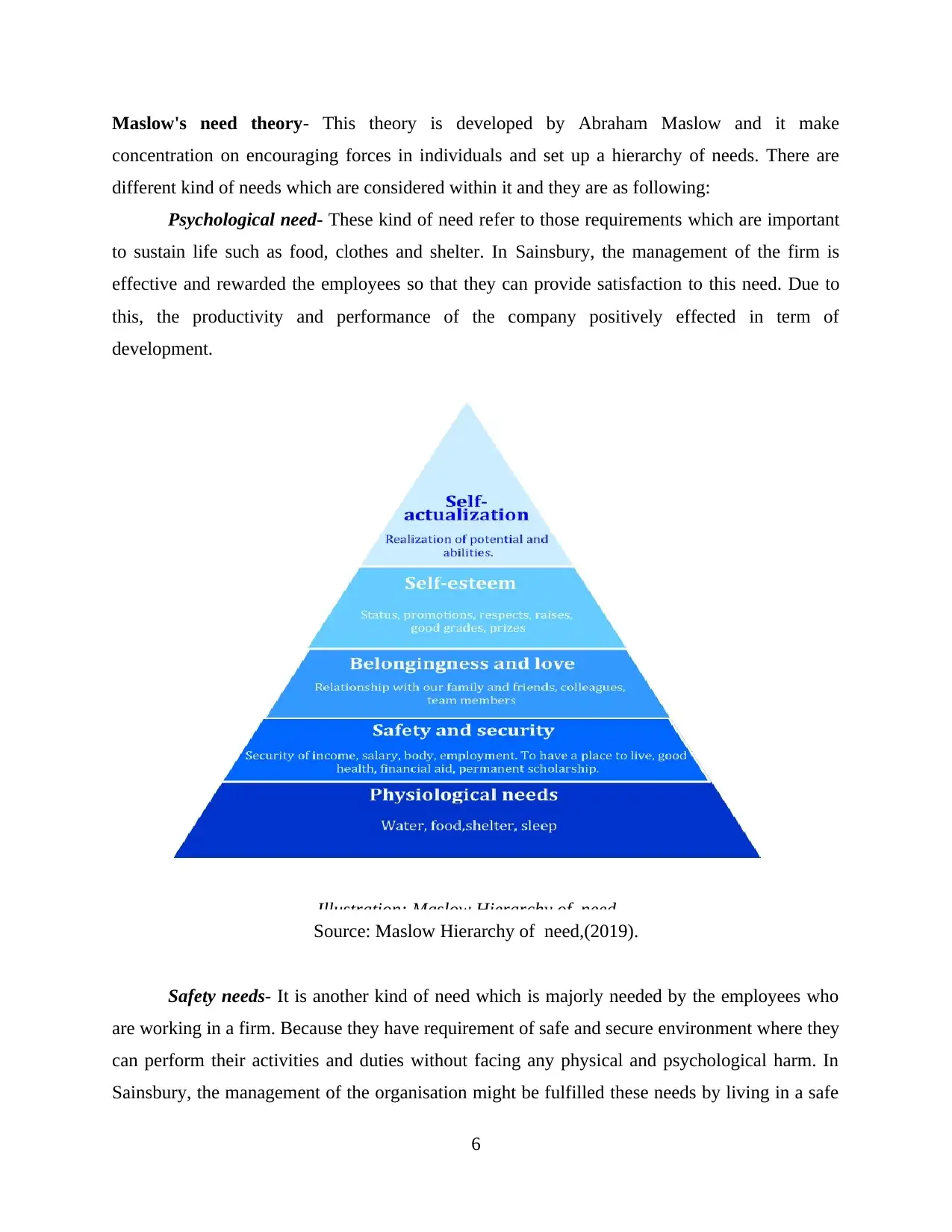
Maslow's need theory- This theory is developed by Abraham Maslow and it make
concentration on encouraging forces in individuals and set up a hierarchy of needs. There are
different kind of needs which are considered within it and they are as following:
Psychological need- These kind of need refer to those requirements which are important
to sustain life such as food, clothes and shelter. In Sainsbury, the management of the firm is
effective and rewarded the employees so that they can provide satisfaction to this need. Due to
this, the productivity and performance of the company positively effected in term of
development.
Source: Maslow Hierarchy of need,(2019).
Safety needs- It is another kind of need which is majorly needed by the employees who
are working in a firm. Because they have requirement of safe and secure environment where they
can perform their activities and duties without facing any physical and psychological harm. In
Sainsbury, the management of the organisation might be fulfilled these needs by living in a safe
6
Illustration: Maslow Hierarchy of need
concentration on encouraging forces in individuals and set up a hierarchy of needs. There are
different kind of needs which are considered within it and they are as following:
Psychological need- These kind of need refer to those requirements which are important
to sustain life such as food, clothes and shelter. In Sainsbury, the management of the firm is
effective and rewarded the employees so that they can provide satisfaction to this need. Due to
this, the productivity and performance of the company positively effected in term of
development.
Source: Maslow Hierarchy of need,(2019).
Safety needs- It is another kind of need which is majorly needed by the employees who
are working in a firm. Because they have requirement of safe and secure environment where they
can perform their activities and duties without facing any physical and psychological harm. In
Sainsbury, the management of the organisation might be fulfilled these needs by living in a safe
6
Illustration: Maslow Hierarchy of need
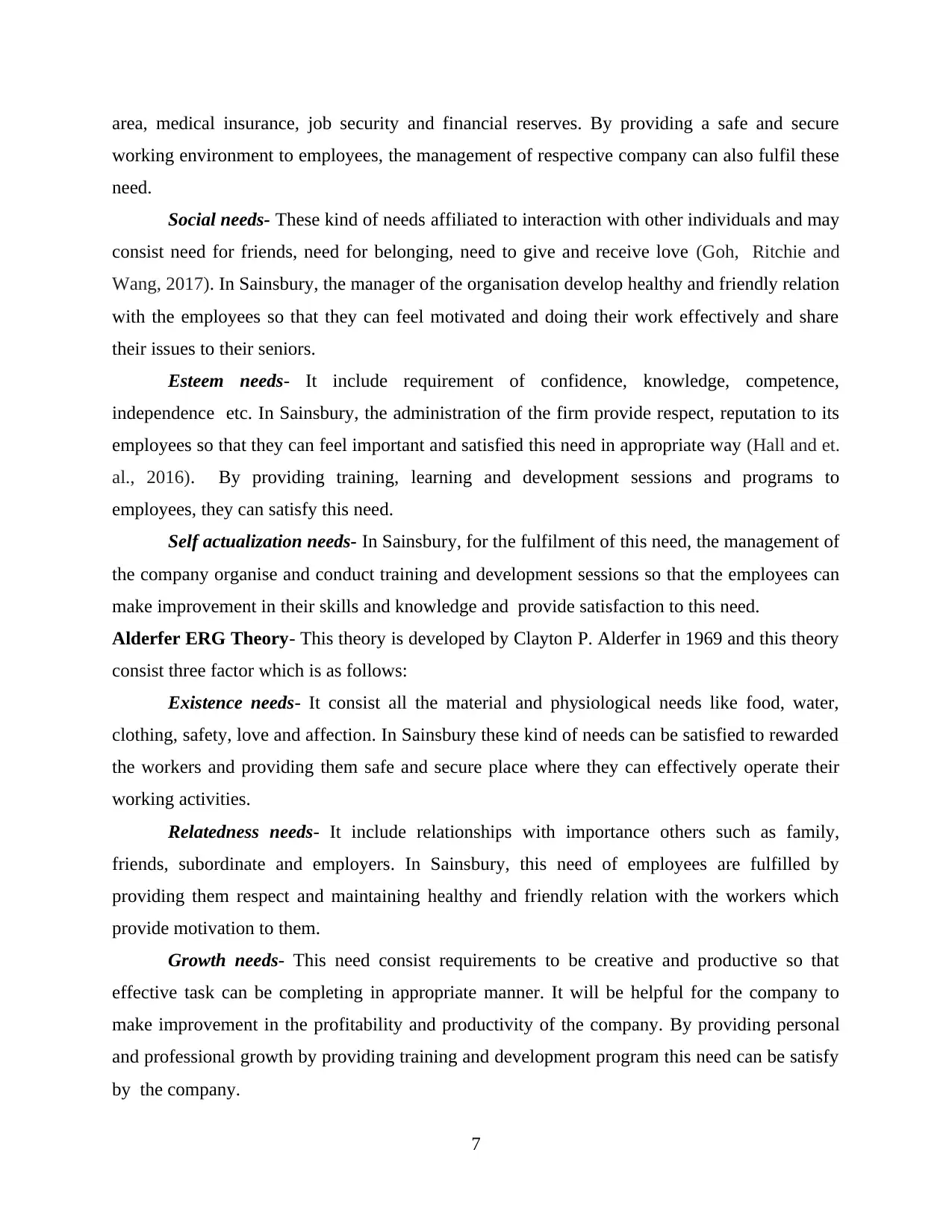
area, medical insurance, job security and financial reserves. By providing a safe and secure
working environment to employees, the management of respective company can also fulfil these
need.
Social needs- These kind of needs affiliated to interaction with other individuals and may
consist need for friends, need for belonging, need to give and receive love (Goh, Ritchie and
Wang, 2017). In Sainsbury, the manager of the organisation develop healthy and friendly relation
with the employees so that they can feel motivated and doing their work effectively and share
their issues to their seniors.
Esteem needs- It include requirement of confidence, knowledge, competence,
independence etc. In Sainsbury, the administration of the firm provide respect, reputation to its
employees so that they can feel important and satisfied this need in appropriate way (Hall and et.
al., 2016). By providing training, learning and development sessions and programs to
employees, they can satisfy this need.
Self actualization needs- In Sainsbury, for the fulfilment of this need, the management of
the company organise and conduct training and development sessions so that the employees can
make improvement in their skills and knowledge and provide satisfaction to this need.
Alderfer ERG Theory- This theory is developed by Clayton P. Alderfer in 1969 and this theory
consist three factor which is as follows:
Existence needs- It consist all the material and physiological needs like food, water,
clothing, safety, love and affection. In Sainsbury these kind of needs can be satisfied to rewarded
the workers and providing them safe and secure place where they can effectively operate their
working activities.
Relatedness needs- It include relationships with importance others such as family,
friends, subordinate and employers. In Sainsbury, this need of employees are fulfilled by
providing them respect and maintaining healthy and friendly relation with the workers which
provide motivation to them.
Growth needs- This need consist requirements to be creative and productive so that
effective task can be completing in appropriate manner. It will be helpful for the company to
make improvement in the profitability and productivity of the company. By providing personal
and professional growth by providing training and development program this need can be satisfy
by the company.
7
working environment to employees, the management of respective company can also fulfil these
need.
Social needs- These kind of needs affiliated to interaction with other individuals and may
consist need for friends, need for belonging, need to give and receive love (Goh, Ritchie and
Wang, 2017). In Sainsbury, the manager of the organisation develop healthy and friendly relation
with the employees so that they can feel motivated and doing their work effectively and share
their issues to their seniors.
Esteem needs- It include requirement of confidence, knowledge, competence,
independence etc. In Sainsbury, the administration of the firm provide respect, reputation to its
employees so that they can feel important and satisfied this need in appropriate way (Hall and et.
al., 2016). By providing training, learning and development sessions and programs to
employees, they can satisfy this need.
Self actualization needs- In Sainsbury, for the fulfilment of this need, the management of
the company organise and conduct training and development sessions so that the employees can
make improvement in their skills and knowledge and provide satisfaction to this need.
Alderfer ERG Theory- This theory is developed by Clayton P. Alderfer in 1969 and this theory
consist three factor which is as follows:
Existence needs- It consist all the material and physiological needs like food, water,
clothing, safety, love and affection. In Sainsbury these kind of needs can be satisfied to rewarded
the workers and providing them safe and secure place where they can effectively operate their
working activities.
Relatedness needs- It include relationships with importance others such as family,
friends, subordinate and employers. In Sainsbury, this need of employees are fulfilled by
providing them respect and maintaining healthy and friendly relation with the workers which
provide motivation to them.
Growth needs- This need consist requirements to be creative and productive so that
effective task can be completing in appropriate manner. It will be helpful for the company to
make improvement in the profitability and productivity of the company. By providing personal
and professional growth by providing training and development program this need can be satisfy
by the company.
7
⊘ This is a preview!⊘
Do you want full access?
Subscribe today to unlock all pages.

Trusted by 1+ million students worldwide
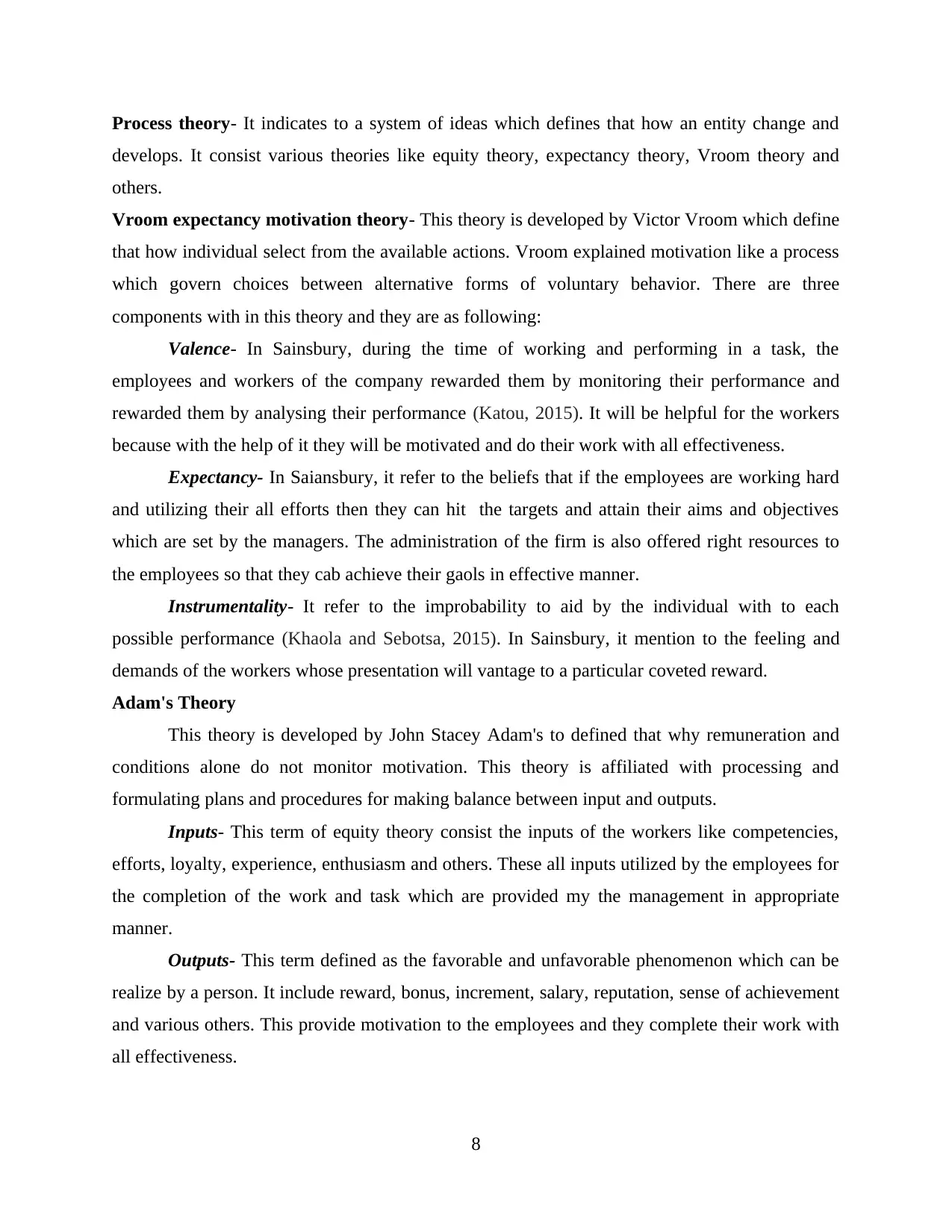
Process theory- It indicates to a system of ideas which defines that how an entity change and
develops. It consist various theories like equity theory, expectancy theory, Vroom theory and
others.
Vroom expectancy motivation theory- This theory is developed by Victor Vroom which define
that how individual select from the available actions. Vroom explained motivation like a process
which govern choices between alternative forms of voluntary behavior. There are three
components with in this theory and they are as following:
Valence- In Sainsbury, during the time of working and performing in a task, the
employees and workers of the company rewarded them by monitoring their performance and
rewarded them by analysing their performance (Katou, 2015). It will be helpful for the workers
because with the help of it they will be motivated and do their work with all effectiveness.
Expectancy- In Saiansbury, it refer to the beliefs that if the employees are working hard
and utilizing their all efforts then they can hit the targets and attain their aims and objectives
which are set by the managers. The administration of the firm is also offered right resources to
the employees so that they cab achieve their gaols in effective manner.
Instrumentality- It refer to the improbability to aid by the individual with to each
possible performance (Khaola and Sebotsa, 2015). In Sainsbury, it mention to the feeling and
demands of the workers whose presentation will vantage to a particular coveted reward.
Adam's Theory
This theory is developed by John Stacey Adam's to defined that why remuneration and
conditions alone do not monitor motivation. This theory is affiliated with processing and
formulating plans and procedures for making balance between input and outputs.
Inputs- This term of equity theory consist the inputs of the workers like competencies,
efforts, loyalty, experience, enthusiasm and others. These all inputs utilized by the employees for
the completion of the work and task which are provided my the management in appropriate
manner.
Outputs- This term defined as the favorable and unfavorable phenomenon which can be
realize by a person. It include reward, bonus, increment, salary, reputation, sense of achievement
and various others. This provide motivation to the employees and they complete their work with
all effectiveness.
8
develops. It consist various theories like equity theory, expectancy theory, Vroom theory and
others.
Vroom expectancy motivation theory- This theory is developed by Victor Vroom which define
that how individual select from the available actions. Vroom explained motivation like a process
which govern choices between alternative forms of voluntary behavior. There are three
components with in this theory and they are as following:
Valence- In Sainsbury, during the time of working and performing in a task, the
employees and workers of the company rewarded them by monitoring their performance and
rewarded them by analysing their performance (Katou, 2015). It will be helpful for the workers
because with the help of it they will be motivated and do their work with all effectiveness.
Expectancy- In Saiansbury, it refer to the beliefs that if the employees are working hard
and utilizing their all efforts then they can hit the targets and attain their aims and objectives
which are set by the managers. The administration of the firm is also offered right resources to
the employees so that they cab achieve their gaols in effective manner.
Instrumentality- It refer to the improbability to aid by the individual with to each
possible performance (Khaola and Sebotsa, 2015). In Sainsbury, it mention to the feeling and
demands of the workers whose presentation will vantage to a particular coveted reward.
Adam's Theory
This theory is developed by John Stacey Adam's to defined that why remuneration and
conditions alone do not monitor motivation. This theory is affiliated with processing and
formulating plans and procedures for making balance between input and outputs.
Inputs- This term of equity theory consist the inputs of the workers like competencies,
efforts, loyalty, experience, enthusiasm and others. These all inputs utilized by the employees for
the completion of the work and task which are provided my the management in appropriate
manner.
Outputs- This term defined as the favorable and unfavorable phenomenon which can be
realize by a person. It include reward, bonus, increment, salary, reputation, sense of achievement
and various others. This provide motivation to the employees and they complete their work with
all effectiveness.
8
Paraphrase This Document
Need a fresh take? Get an instant paraphrase of this document with our AI Paraphraser
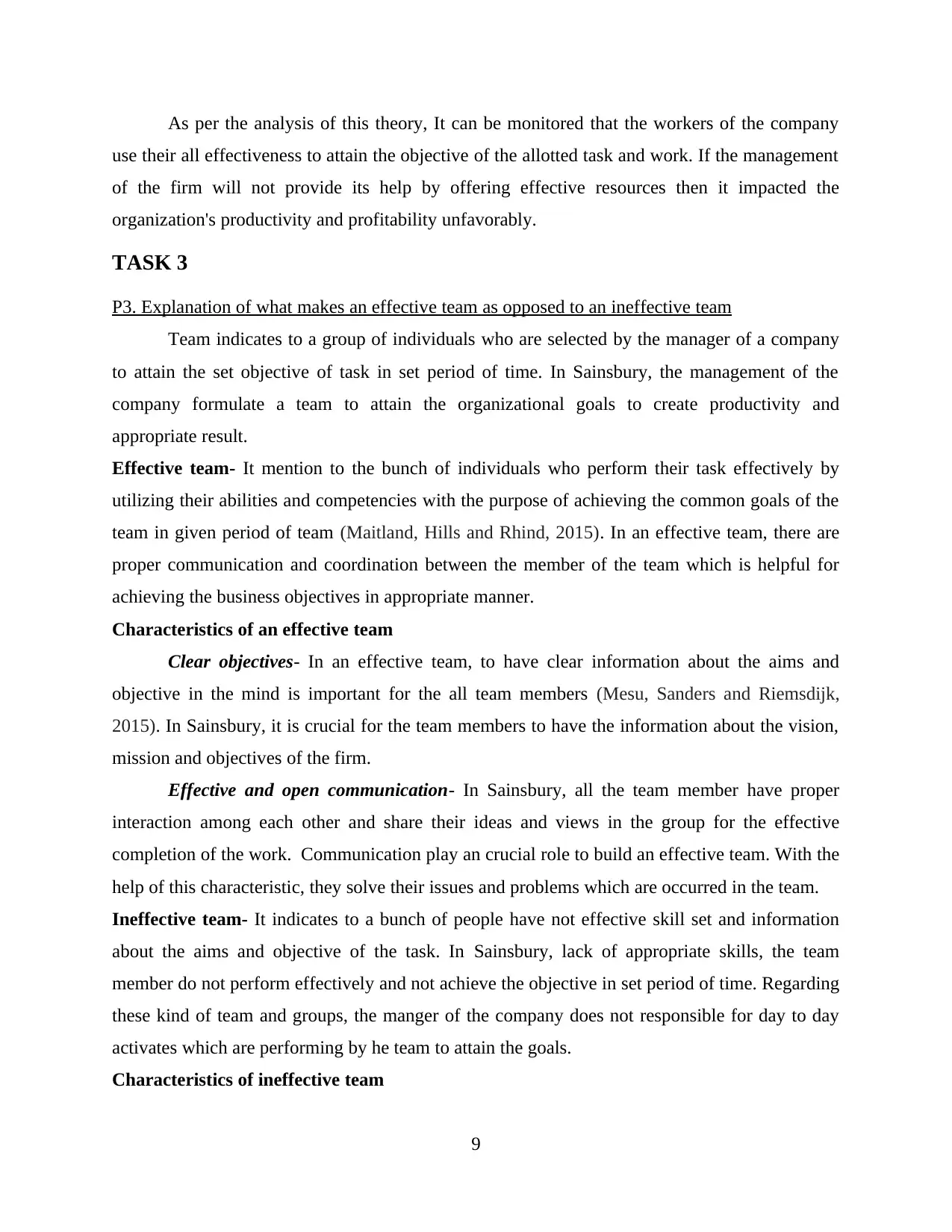
As per the analysis of this theory, It can be monitored that the workers of the company
use their all effectiveness to attain the objective of the allotted task and work. If the management
of the firm will not provide its help by offering effective resources then it impacted the
organization's productivity and profitability unfavorably.
TASK 3
P3. Explanation of what makes an effective team as opposed to an ineffective team
Team indicates to a group of individuals who are selected by the manager of a company
to attain the set objective of task in set period of time. In Sainsbury, the management of the
company formulate a team to attain the organizational goals to create productivity and
appropriate result.
Effective team- It mention to the bunch of individuals who perform their task effectively by
utilizing their abilities and competencies with the purpose of achieving the common goals of the
team in given period of team (Maitland, Hills and Rhind, 2015). In an effective team, there are
proper communication and coordination between the member of the team which is helpful for
achieving the business objectives in appropriate manner.
Characteristics of an effective team
Clear objectives- In an effective team, to have clear information about the aims and
objective in the mind is important for the all team members (Mesu, Sanders and Riemsdijk,
2015). In Sainsbury, it is crucial for the team members to have the information about the vision,
mission and objectives of the firm.
Effective and open communication- In Sainsbury, all the team member have proper
interaction among each other and share their ideas and views in the group for the effective
completion of the work. Communication play an crucial role to build an effective team. With the
help of this characteristic, they solve their issues and problems which are occurred in the team.
Ineffective team- It indicates to a bunch of people have not effective skill set and information
about the aims and objective of the task. In Sainsbury, lack of appropriate skills, the team
member do not perform effectively and not achieve the objective in set period of time. Regarding
these kind of team and groups, the manger of the company does not responsible for day to day
activates which are performing by he team to attain the goals.
Characteristics of ineffective team
9
use their all effectiveness to attain the objective of the allotted task and work. If the management
of the firm will not provide its help by offering effective resources then it impacted the
organization's productivity and profitability unfavorably.
TASK 3
P3. Explanation of what makes an effective team as opposed to an ineffective team
Team indicates to a group of individuals who are selected by the manager of a company
to attain the set objective of task in set period of time. In Sainsbury, the management of the
company formulate a team to attain the organizational goals to create productivity and
appropriate result.
Effective team- It mention to the bunch of individuals who perform their task effectively by
utilizing their abilities and competencies with the purpose of achieving the common goals of the
team in given period of team (Maitland, Hills and Rhind, 2015). In an effective team, there are
proper communication and coordination between the member of the team which is helpful for
achieving the business objectives in appropriate manner.
Characteristics of an effective team
Clear objectives- In an effective team, to have clear information about the aims and
objective in the mind is important for the all team members (Mesu, Sanders and Riemsdijk,
2015). In Sainsbury, it is crucial for the team members to have the information about the vision,
mission and objectives of the firm.
Effective and open communication- In Sainsbury, all the team member have proper
interaction among each other and share their ideas and views in the group for the effective
completion of the work. Communication play an crucial role to build an effective team. With the
help of this characteristic, they solve their issues and problems which are occurred in the team.
Ineffective team- It indicates to a bunch of people have not effective skill set and information
about the aims and objective of the task. In Sainsbury, lack of appropriate skills, the team
member do not perform effectively and not achieve the objective in set period of time. Regarding
these kind of team and groups, the manger of the company does not responsible for day to day
activates which are performing by he team to attain the goals.
Characteristics of ineffective team
9
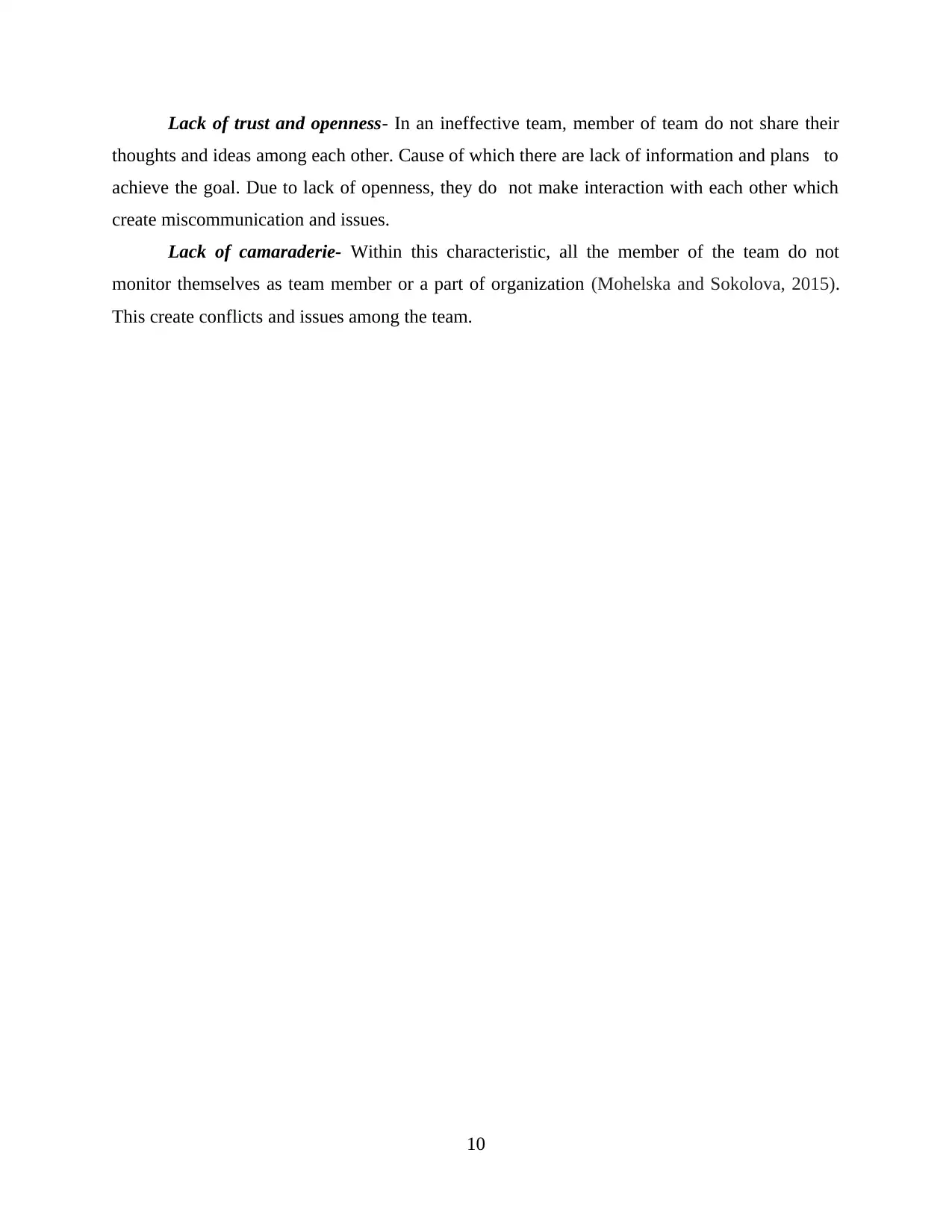
Lack of trust and openness- In an ineffective team, member of team do not share their
thoughts and ideas among each other. Cause of which there are lack of information and plans to
achieve the goal. Due to lack of openness, they do not make interaction with each other which
create miscommunication and issues.
Lack of camaraderie- Within this characteristic, all the member of the team do not
monitor themselves as team member or a part of organization (Mohelska and Sokolova, 2015).
This create conflicts and issues among the team.
10
thoughts and ideas among each other. Cause of which there are lack of information and plans to
achieve the goal. Due to lack of openness, they do not make interaction with each other which
create miscommunication and issues.
Lack of camaraderie- Within this characteristic, all the member of the team do not
monitor themselves as team member or a part of organization (Mohelska and Sokolova, 2015).
This create conflicts and issues among the team.
10
⊘ This is a preview!⊘
Do you want full access?
Subscribe today to unlock all pages.

Trusted by 1+ million students worldwide
1 out of 20
Related Documents
Your All-in-One AI-Powered Toolkit for Academic Success.
+13062052269
info@desklib.com
Available 24*7 on WhatsApp / Email
![[object Object]](/_next/static/media/star-bottom.7253800d.svg)
Unlock your academic potential
Copyright © 2020–2025 A2Z Services. All Rights Reserved. Developed and managed by ZUCOL.





